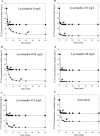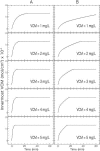Novel mechanism of antibiotic resistance originating in vancomycin-intermediate Staphylococcus aureus
- PMID: 16436693
- PMCID: PMC1366884
- DOI: 10.1128/AAC.50.2.428-438.2006
Novel mechanism of antibiotic resistance originating in vancomycin-intermediate Staphylococcus aureus
Abstract
As an aggressive pathogen, Staphylococcus aureus poses a significant public health threat and is becoming increasingly resistant to currently available antibiotics, including vancomycin, the drug of last resort for gram-positive bacterial infections. S. aureus with intermediate levels of resistance to vancomycin (vancomycin-intermediate S. aureus [VISA]) was first identified in 1996. The resistance mechanism of VISA, however, has not yet been clarified. We have previously shown that cell wall thickening is a common feature of VISA, and we have proposed that a thickened cell wall is a phenotypic determinant for vancomycin resistance in VISA (L. Cui, X. Ma, K. Sato, et al., J. Clin. Microbiol. 41:5-14, 2003). Here we show the occurrence of an anomalous diffusion of vancomycin through the VISA cell wall, which is caused by clogging of the cell wall with vancomycin itself. A series of experiments demonstrates that the thickened cell wall of VISA could protect ongoing peptidoglycan biosynthesis in the cytoplasmic membrane from vancomycin inhibition, allowing the cells to continue producing nascent cell wall peptidoglycan and thus making the cells resistant to vancomycin. We conclude that the cooperative effect of the clogging and cell wall thickening enables VISA to prevent vancomycin from reaching its true target in the cytoplasmic membrane, exhibiting a new class of antibiotic resistance in gram-positive pathogens.
Figures







References
-
- Barna, J., and D. Williams. 1984. The structure and mode of action of glycopeptide antibiotics of the vancomycin group. Annu. Rev. Microbiol. 38:339-357. - PubMed
-
- Bischoff, M., M. Roos, J. Putnik, A. Wada, P. Glanzmann, P. Giachino, P. Vaudaux, and B. Berger-Bachi. 2001. Involvement of multiple genetic loci in Staphylococcus aureus teicoplanin resistance. FEMS Microbiol. Lett. 194:77-82. - PubMed
-
- Centers for Disease Control and Prevention. 2002. Staphylococcus aureus resistant to vancomycin—United States. Morb. Mortal. Wkly. Rep. 51:565-567. - PubMed
Publication types
MeSH terms
Substances
LinkOut - more resources
Full Text Sources
Research Materials
Miscellaneous

